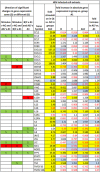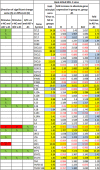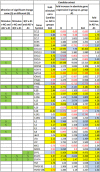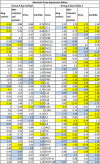Immune characteristics correlating with HSV-1 immune control and effect of squaric acid dibutyl ester on immune characteristics of subjects with frequent herpes labialis episodes
- PMID: 30756512
- PMCID: PMC6416766
- DOI: 10.1002/iid3.241
Immune characteristics correlating with HSV-1 immune control and effect of squaric acid dibutyl ester on immune characteristics of subjects with frequent herpes labialis episodes
Abstract
Introduction: Differences in immune characteristics, including immune gene expression by peripheral blood mononuclear cells (PBMCs), correlating with herpes labialis and good or poor immune control of herpes simplex virus type 1 (HSV-1), and how these characteristics change after dosing with squaric acid dibutyl ester (SADBE), were investigated.
Methods: PBMCs were collected from persons positive for IgG against HSV-1 and having frequent, infrequent, or no herpes labialis outbreaks. The PBMCs were tested for proliferation against HSV-1 and a fungal antigen (Candida) and immune gene expression in the presence of HSV-1 and Candida. On day 1 after blood collection the subjects with frequent outbreaks were dosed topically on the arm once with SADBE, and their PBMCs were collected and tested 8 weeks later.
Results: Those with good immune control of their HSV-1 infection (fewer outbreaks) differ from those with poorer immune control in these ways: (1) Greater PBMC proliferation in vitro to HSV-1, HSV-1-infected cell extracts, and Candida considered together (P < 0.01). (2) Higher expression of IFNG and five other immune-related genes (P < 0.05 for each) and lower expression of IL5 and two other immune-related genes (P < 0.05 for each) in PBMCs in vitro stimulated with HSV-1 virus. The subjects with frequent outbreaks were treated once with SADBE, and 56 days later the PBMCs of these subjects differed from PBMCs from the same subjects taken on day 1 before treatment in exactly the same ways listed above as differences between those with good and poor immune control of HSV-1, and at the same levels of significance.
Conclusions: Higher IFNG and lower IL5 expression by PBMCs in the presence of HSV-1 correlate with fewer herpes labialis outbreaks, and a single topical dose of SADBE to the arm of subjects with frequent herpes labialis episodes improves immune response to HSV-1.
Keywords: herpes labialis; herpes simplex; herpesvirus 1; interferon gamma; interleukin-5; squaric acid; squaric acid dibutyl ester.
© 2019 The Authors. Immunity, Inflammation and Disease Published by John Wiley & Sons Ltd.
Figures










References
-
- Woo S. B., Challacombe S. J. Management of recurrent oral herpes simplex infections. Oral Surg Oral Med Oral Pathol Oral Radiol Endod. 2007; 103:e11–e18. - PubMed
-
- Sarnoff D. S. Treatment of recurrent herpes labialis. J Drugs Dermatol. 2014; 13:1016–1018. - PubMed
-
- Parks C. G., Andrew M. E., Blanciforti L. A., Luster M. I. Variation in the WBC differential count and other factors associated with reporting of herpes labialis: a population‐based study of adults. FEMS Immunol Med Microbiol. 2007; 51:336–343. - PubMed
-
- Lorette G., Crochard A., Mimaud V., Wolkenstein P., Stalder J. F., El Hasnaoui A. A survey on the prevalence of orofacial herpes in France: the INSTANT study. J Am Acad Dermatol. 2006; 55:225–232. - PubMed
MeSH terms
Substances
LinkOut - more resources
Full Text Sources
Other Literature Sources
Medical

